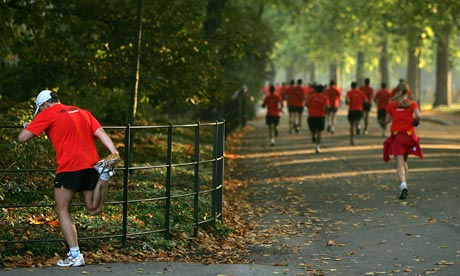The improver: Matt Kurton
It was fairly unusual, as Wednesday afternoons go. I was lying on my back in the middle of Regent's Park, getting instructions on the best way to move my pelvis up and down from a woman I'd only met half an hour before. Next to us, a photographer was busily snapping away. What sort of prize was this?
As it turned out, it was a prize that's already had a serious impact on my running. (And in case Sam Murphy's boyfriend is reading this, I should point out that the pelvic lifting was a type of stretch. Apparently he runs marathons in 2.30 hours, so he won't have any trouble catching up with me if he feels the need.)
Running expert Sam is a font of information on everything from energy drinks (I need to start drinking them earlier during my long runs) to compression tights (which will speed up my recovery, while no doubt making me look just as ridiculous as I do in my standard pair) to keeping your arms loose but strong (by relaxing your thumbs, bizarrely). But two particular things have stuck in my head since our first session.
The first is Sam's observation that I'm my own worst enemy. I'd never really thought about it like that, but it makes a lot of sense. What she meant was that I have a tendency to push myself too hard - increasing mileage on the weeks when I'm supposed to let my body recover, always running at a pretty hard pace - and this, as she put it, is a high-risk strategy. I'm still carrying a niggling groin injury, so it's even more important that I take it steady and build things up slowly. So that's what I'm trying to do. It's a marathon, not a sprint, after all.
The second piece of advice is about cadence - how frequently your feet touch the ground as you run. Most cyclists concentrate on maintaining a high cadence - turning the pedals at high frequency in a low gear, rather than vice-versa - and the same logic applies to running. Keep turning your feet over quickly, Sam explained, and you'll move faster, more easily. Short, frequent strides, with your foot landing underneath your body, are the way forward. Literally.
So we counted the number of strides I was taking in a minute. Then Sam got me to concentrate on taking shorter, quicker steps. How? By running to the beat of Rock Around The Clock by Bill Haley and the Comets. It actually works! My stride-rate increased. I'm still getting used to this one - and still having to work hard not to speed up by too much by taking more strides. But it is already feeling more comfortable and more natural.
All in all, it was a really useful, eye-opening session. A run around the park, some sprints, plenty of stretching and a wealth of brilliant advice. And at the end of it all, me, feeling newly inspired and with a big grin on my face.
Speaking of which, why is it that runners very rarely acknowledge each other? Cyclists always do it - go for a ride out in the country on a Sunday afternoon anywhere, and if you pass a cyclist, you say hello and they say hello. Simple. Runners don't. In fact, most of them scowl. One of the few exceptions was the bloke who used to give me a high five whenever I saw him, which would leave me chuckling for most of the next mile. So what do you think: is there no such thing as a running community? Do people want to be left alone? Are we just miserable? Or do I have a scary face?
Whatever the answer, I'd appreciate a smile if you happen to pass me next time I'm out.
Common mistakes by experienced runners
By Sam Murphy
Running too slow
With 26.2 miles to conquer, it's easy to understand why marathoners in training often focus on long, slow runs to build up their mileage. But if you only ever train slow, you'll only ever race slow. Think quality, not quantity. In practice, that means doing some of your training miles at a pace faster than you intend to run on race day. If you train three times a week, one session should be devoted to faster-paced efforts. If you train five times a week or more, make it two sessions. This brings a different range of physiological benefits than running slowly does, as well as making your training more interesting and honing your running technique.
Ignoring niggles
Niggling pains, like a sore Achilles or a creaky knee, are all part of being a runner, right? The best thing to do is to run them off. No, no, NO! Although such aches and pains are almost badges of honour in some runners' mentalities, ignoring them (or worse still, running through them) tends to turn them into full-blown injuries that can take much longer to get over. If something hurts, ease up, stretch it out and when you can, ice it. And if it hurts, don't run on it. If rest and ice don't help, see a sports medicine practitioner, such as a physiotherapist, to see what the problem is. The key to successful running is consistency - and it's only if you can train for prolonged periods, injury-free, that you'll achieve that consistency.
Not tapering
This, in my experience, is the biggest reason that people don't run as well as they are capable of. They simply don't allow enough time to 'taper' their training, which means they aren't properly recovered come race day. DO NOT do a long run any closer to race day than three weeks before, and DO NOT do a half-marathon one or two weeks out (many marathon programmes actually recommend this, much to my irritation!) Successful tapering means reducing the volume of your training (ie the distance/time you run for), whilst maintaining some of the intensity (speed). Studies demonstrate that a three-week taper is optimal for a marathon, potentially knocking minutes off your finish time.
The beginner: Carol Williamson
My first meeting with Sam Murphy was on Sunday and it transpires that, like Matt, I am (incorrectly) running all my sessions at the same pace. Matt, of course, was running them too fast. It is safe to say that I am not.
My schedule up to now has been three or four weekday 5-6 mile runs at marathon pace with an attempt at a long run at the weekend. Sam is of the firm opinion I need to introduce some faster-paced work to improve my technique and running economy, and she assures me this will make training more interesting.
When she says this faster pace should be akin to "controlled discomfort" I am sceptical about enjoyment levels rising, but we head out to Regent's Park to give it a go. We find a triangular circuit and she sets me off round the triangle at a faster-than-race pace. She asks if I can still get the odd word out and I manage a strangled "yes". At the completion of the circuit I am allowed a 90-second recovery, and apparently the fact that I do not have my hands on my knees with my head between then is a good sign and means I am working in the right zone.
We complete this a couple more times, followed by a warm down jog. I admit it is fun to do something a little different. I also feel I've worked just as hard as on my 5-6m runs but in a shorter period of time, which has to be good news. Sam suggests I should also try some hill training. I loathe hills and am quick protest that there aren't any in Battersea, but she is having none of it ("There's always the treadmill, darling.")
The other big change to my existing programme is to take out some sessions (I needn't be running more than 30m a week at this stage) and do my longer run at a slower-than-race pace, which should enable me to get the miles up every week. So a typical week will be one long, slow run, one faster-paced interval session, and one or sometimes two shorter runs at marathon pace. Pilates and/or strength training are also good on my days off.
Having a fewer number of running sessions and being able to do the longer run at, say, a 10-minute mile pace suddenly makes this endeavour look more manageable. After our session I feel really enthusiastic about the whole thing. On Monday morning my new improved training schedule appears on email as promised, along with some advice on nutrition. I am ready to go.
Common mistakes by beginners
By Sam Murphy
Too much, too soon
Many first-timers try to build up their training too quickly. They get a marathon place and then panic. It is an especially common mistake among newbie runners who are aerobically fit from other sports. Their hearts and lungs are up for the challenge, but it takes longer for the musculoskeletal system to adapt to the unique demands of running. The golden rule is to make haste slowly. Only increase the overall amount of running you do by 10% a week.
A one-trick pony
Another common pitfall is ditching all other physical activities to train for the marathon. Someone who has been doing, say, circuit training, or hitting the gym a couple of times a week, or taking a weekly swim or yoga class, casts this aside in order to make more time for training. The trouble is, running is a uni-directional, highly repetitive and demanding activity. Balancing it out with other sports or pastimes is actually a smart move, both in terms of injury prevention (by maintaining strength and flexibility) and development of fitness.
Sticking to the programme - through thick and thin
It's important to have a progressive, structured programme to follow when you are marathon training. But it isn't set in stone. Just because the schedule says do 12 miles, the sky won't fall down if you do nine! You have to listen to your body as you train and respond to its needs, particularly the need for sufficient rest and recovery. Also, make sure that the programme you follow is appropriate for your level of fitness and experience. Your initial aim should be to complete, not compete.
Next week: We focus on what to eat to get the best running results
Are you committing any of these cardinal running sins? Or perhaps you have some good training advice to share. Let us know in the comments section below











